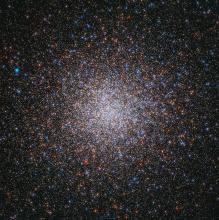Listen to today's episode of StarDate on the web the same day it airs in high-quality streaming audio without any extra ads or announcements. Choose a $8 one-month pass, or listen every day for a year for just $30.
You are here
Moon and Aldebaran
The face of Taurus, the bull, is doomed. The V-shaped face is outlined by a star cluster known as the Hyades. But the cluster is falling apart.
The Hyades is the closest major big cluster to the Sun — about 150 light-years away. All of its stars were born about 650 million years ago, from a giant cloud of gas and dust. Today, the stars all move through space together, as a single unit. But the cluster is less impressive today than it was in the past.
A recent study looked at observations of stars in and around the Hyades by Gaia, a space telescope. It’s measuring the positions and motions of a billion stars. It revealed 500 members of the cluster itself. But it also revealed two “tails” of stars near the cluster — one ahead of it, and the other behind. Together, they contain more than 500 stars.
The stars in these tails are about the same age as the stars of the Hyades. They also have the same chemistry, and they move with the same speed and in the same direction as the Hyades. That suggests the stars were members of the cluster in the past. They were kicked out by encounters with other stars, or by the gravitational pull of the rest of the galaxy.
So someday, the entire cluster may be pulled apart — destroying the face of the bull.
Look for the face at dawn tomorrow to the right of the Moon. The bright star close to the Moon is Aldebaran, the bull’s eye. Although it’s at one point of the V, it doesn’t belong to the cluster — it’s on its own.
Script by Damond Benningfield




